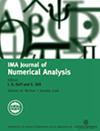Itôdiffusions退出时间的高阶自适应方法
IF 2.3
2区 数学
Q1 MATHEMATICS, APPLIED
引用次数: 0
摘要
我们构造了一种高阶自适应方法来强逼近随机微分方程的退出时间。该方法采用强It–Taylor格式来模拟SDE路径,并随着解接近域的边界而自适应地减小数值积分中的步长。这些技术很好地相互补充:自适应时间步进通过减少数值解退出域时的超调幅度来提高退出时间的准确性,而高阶方案则改进了扩散过程状态的近似。我们提出了两种高阶自适应方法。第一种方法使用Milstein格式作为数值积分器,并使用两个步长进行自适应时间步长:远离边界时为$h$,靠近边界时为$h^2$。第二种方法是第一种方法的扩展,使用1.5阶的强It–Taylor格式作为数值积分器,并使用三个步长进行自适应时间步长。在一些正则性假设下,我们证明了对于任何$\neneneba xi&;gt;0$,对于第一种和第二种方法,强错误分别为${\mathcal{O}}(h^{1-\neneneba xi}。假设扩散系数的交换性条件非常严格,我们进一步证明了这两种方法的预期计算成本是${\mathcal{O}}(h^{-1}\log(h^{-1}))$。与基于Euler–Maruyama的标准方法相比,这导致强错误率几乎翻了一番/三倍,同时计算成本率保持在接近一阶。提供了支持理论结果的数值例子,我们讨论了进一步提高该方法强收敛速度的扩展潜力。本文章由计算机程序翻译,如有差异,请以英文原文为准。
Higher-order adaptive methods for exit times of Itô diffusions
We construct a higher-order adaptive method for strong approximations of exit times of Itô stochastic differential equations (SDEs). The method employs a strong Itô–Taylor scheme for simulating SDE paths, and adaptively decreases the step size in the numerical integration as the solution approaches the boundary of the domain. These techniques complement each other nicely: adaptive timestepping improves the accuracy of the exit time by reducing the magnitude of the overshoot of the numerical solution when it exits the domain, and higher-order schemes improve the approximation of the state of the diffusion process. We present two versions of the higher-order adaptive method. The first one uses the Milstein scheme as the numerical integrator and two step sizes for adaptive timestepping: $h$ when far away from the boundary and $h^2$ when close to the boundary. The second method is an extension of the first one using the strong Itô–Taylor scheme of order 1.5 as the numerical integrator and three step sizes for adaptive timestepping. Under some regularity assumptions, we show that for any $\xi>0$, the strong error is ${\mathcal{O}}(h^{1-\xi })$ and ${\mathcal{O}}(h^{3/2-\xi })$ for the first and second method, respectively. Provided quite restrictive commutativity conditions hold for the diffusion coefficient, we further show that the expected computational cost for both methods is ${\mathcal{O}}(h^{-1} \log (h^{-1}))$. This results in a near doubling/trebling of the strong error rate compared to the standard Euler–Maruyama-based approach, while the computational cost rate is kept close to order one. Numerical examples that support the theoretical results are provided, and we discuss the potential for extensions that would further improve the strong convergence rate of the method.
求助全文
通过发布文献求助,成功后即可免费获取论文全文。
去求助
来源期刊
CiteScore
5.30
自引率
4.80%
发文量
79
审稿时长
6-12 weeks
期刊介绍:
The IMA Journal of Numerical Analysis (IMAJNA) publishes original contributions to all fields of numerical analysis; articles will be accepted which treat the theory, development or use of practical algorithms and interactions between these aspects. Occasional survey articles are also published.

 求助内容:
求助内容: 应助结果提醒方式:
应助结果提醒方式:


